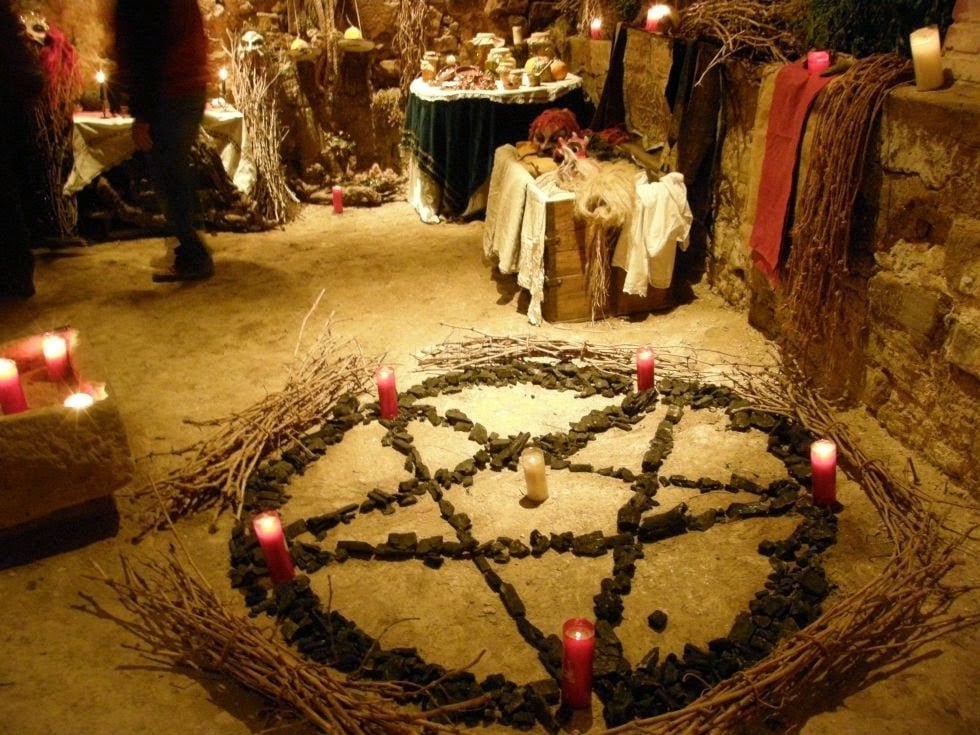
Set up: place a candle in each of the four cardinal directions. Lay the rest of the tools on the altar cloth or near it. The altar can be on the ground, a table, a rock or a stump. The altar should be in the center or just north of center of the Circle. Light the six candles and the incense, start the music and begin the ritual.
The Ritual
Facing North, the High Priest and Priestess kneel in front of the altar with him to her right. She puts the bowl of water on the altar, places the point of her athame in it and says:
“I exorcise thee, O Creature of Water, that thou cast out from thee all impurities and uncleanliness of the world of phantasm; in the names of Cernunnos and Aradia”
She then puts down her athame and holds up the bowl of water in both hands. The High Priest puts the bowl of salt on the altar, puts his athame in the salt and says:
“Blessings be upon this Creature of Salt; let all malignity and hindrance be cast forth hence, and let all good enter herein; wherefore so I bless thee, that thou mayest aid me, in the names of Cernunnos and Aradia.”
He then puts down his athame and pours the salt into the bowl of water the High Priestess is holding. The High Priest then stands with the rest of the Coven outside the Circle. The High Priestess then draws the Circle with the sword, leaving a gap in the Northeast section. While drawing the Circle, she should visualize the power flowing into the Circle from off the end of the sword. She draws the Circle in a East to North or deosil or clockwise direction. She says:
“I conjure thee, O Circle of Power, that thou beest a meeting place of love and joy and truth; a shield against all wickedness and evil; a boundary between men and the realms of the Mighty Ones; a rampart and protection that shall preserve and contain the power that we shall raise within thee. Wherefore do I bless thee and consecrate thee, in the names of Cernunnos and Aradia.”
The High Priestess lays down the sword and admits the High Priest with a kiss while spinning him deosil and whispers “Bless Be” .He then admits a women the same way. Alternate male female male. Then the High Priestess finishes closing the Circle with the sword. She then names three witches to help strengthen the Circle. The first witch carries the bowl of consecrated water from East to East going deosil, sprinkling the perimeter as she/he goes. They then sprinkle each member in turn. If the witch is male, he sprinkles the High Priestess last who then sprinkles him. If female she sprinkles the High Priest last, who then sprinkles her. The bowl is replaced on the altar. The second witch takes the incense burner around the perimeter and the third takes one of the altar candles. While going around the perimeter, each person says:
“Black spirits and white,
Red spirits and gray,
Harken to the rune I say.
Four points of the Circle, weave the spell,
East, South, West, North, your tale tell.
East is for break of day,
South is white for the noontide hour,
In the West is twilight gray,
And North is black, for the place of power.
Three times round the Circle’s cast.
Great ones, spirits from the past,
Witness it and guard it fast.”
All the Coven pickup their athames and face the East with the High Priest and Priestess in front, him on her right. The High Priestess says:
“Ye Lords of the Watchtowers of the East, ye Lords of Air; I do summon, stir, and call you up to witness our rites and to guard the Circle.”
As she speaks she draws the Invoking Pentagram of Earth in the air with her athame. The High Priest and the rest of the Coven copy her movements with their athames. The High Priestess turns and faces the South and repeats the summoning:
“Ye Lords of the Watchtowers of the South, ye Lords of Fire; I do summon, stir and call you up, to witness our rites and to guard the Circle.”
She does the same pentagram and then faces West and says:
“Ye Lords of the Watchtowers of the West, ye Lords of Water, ye Lords of Death and Initiation; I do summon, stir, and call you up, to witness our rites and to guard the Circle.”
She faces North with rest of the Coven and says:
“Ye Lords of the Watchtowers of the North, ye Lords of Earth; Boreas, thou gentle guardian of the Northern Portals; thou powerful God and gentle Goddess; we do summon, stir and call you up, to witness our rites and to guard the Circle.”
The Circle is completed and sealed. If anyone needs to leave, a gate must be made. Using the sword, draw out part of the Circle with a widdershins or counterclockwise stroke. Immediately reseal it and then repeat the opening and closing when the person returns.

